The Nexus 6 Review
by Brandon Chester on November 12, 2014 1:00 PM ESTDisplay
The display is one of the most important aspects of a smartphone, as it is the part of the device that the user will interact with most. We've seen tremendous improvement in smartphone displays as they have become more and more commonplace within society. The first area of improvement was resolution, which made sense with text being a necessary part of essentially every smartphone application. As displays have gotten to the point where there is little benefit to further increasing pixel density, we have also seen a push for greater color accuracy and image rendition. On the Android side of the market, Google was one of the first companies to start taking color accuracy seriously, and the Nexus 7 and Nexus 5 had some of the best calibrated displays of all Android devices.
The Nexus 6 sports a 5.96" AMOLED display with a resolution of 2560x1440. Given Google's work to provide accurate color calibration on the Nexus 5, and the massive improvements that we've seen in the calibration of AMOLED displays over the course the past year, I was very excited to take a look at the display on the Nexus 6. However, as someone who typically uses the very well calibrated iPhone 6 and Nexus 5 in daily use, I immediately noticed that the Nexus 6 produced a punchier image than I was used to seeing in the applications I use frequently.
To take a look at the characteristics of the Nexus 6's display we turn to SpectraCal's CalMAN 5 software and an X-Rite i1 Pro 2 spectrophotometer for accurate measurements of the display's color. As always, we target the sRGB gamut which is currently the standard for photos on the web and video content.
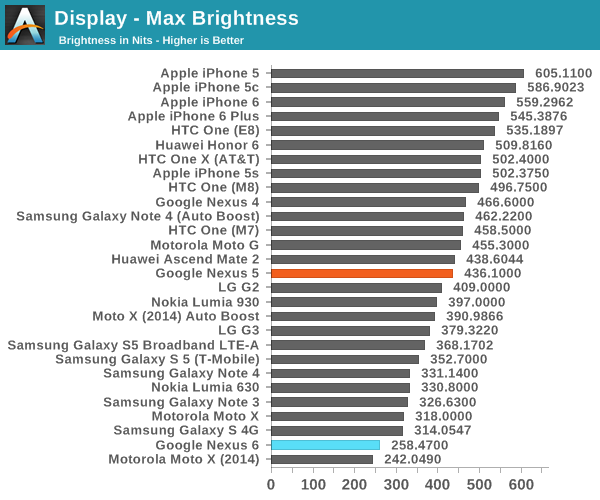
Contrast and black levels on the Nexus 6 are as incredible as ever. Brightness is definitely on the low side though. Testing was performed with both the manual brightness settings, and with Adaptive Brightness enabled and a bright LED aimed at the light sensor. In both cases the maximum brightness was the same, there's no higher brightness exposed when using the automatic brightness settings like there is for the Galaxy Note 4. What's interesting to note is that the brightness is similar to that of the 2014 Moto X, another recently released Motorola device that sports an AMOLED panel. However, even Moto X has an auto boost mode which pushes it up to 390nits. The overall similarity between the panel in the Moto X and the panel in the Nexus 6 persists throughout our other tests.
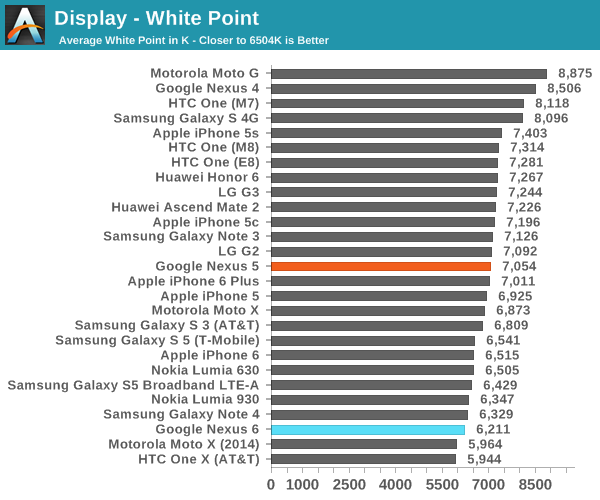
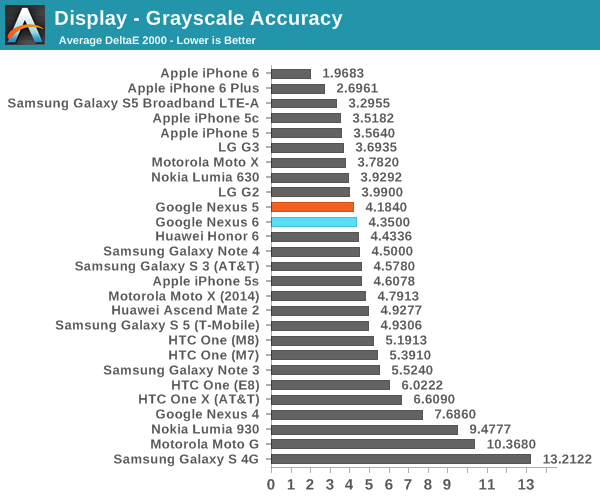
The Nexus 6 is slightly more red than our target for white point, though not to the extent of the 2014 Moto X. This contrasts with the IPS panel in the Nexus 5 which was too blue. In the greyscale we see that the luminance is comprised more of red and green than of blue. This translates to greyscale performance that is nothing exceptional, but not noticably worse than the Nexus 5, and still significantly improved compared to AMOLED panels from not long ago like the display in the Galaxy Note 3.
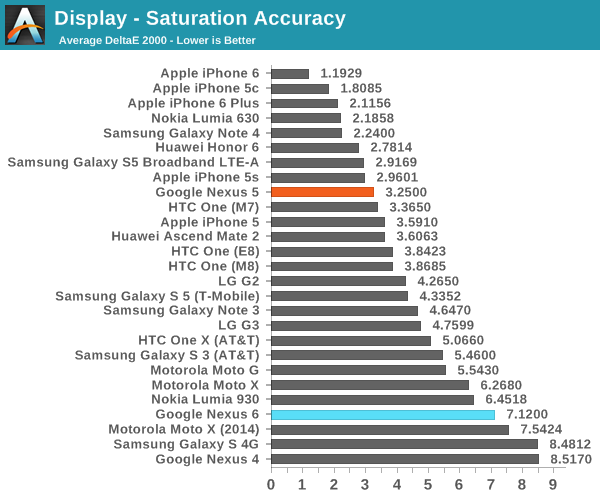
In our saturation sweep test, the Nexus 6 performs rather poorly. Unlike Samsung's phones which have several display modes with one of them targeting sRGB, the Nexus 6 has only one display setting and it significantly overshoots the sRGB gamut. This does a good job at creating showroom appeal but is not helpful in accurately displaying the color in photos and videos. This is especially disappointing because the Nexus 5 was well calibrated to sRGB and performed much better in this test.
The poor performance in the saturation sweep translates to equally poor performance on the ColorChecker test. The expanded gamut and saturation compression makes it effectively impossible for this display to render any sRGB content accurately. The greyscale performance helps to bring down the overall average, but the large errors with color mixtures prevent any sort of accurate image rendition.
I was highly disappointed by these results. Like I said earlier, we've seen great improvements in the quality of AMOLED displays as of late, and Google took color calibration very seriously with the Nexus 5. The Nexus 6 shows significant regression in color accuracy from the Nexus 5, and the maximum brightness is much lower. It should also be noted that despite its higher resolution, its larger size means that compared to the Nexus 5 the pixel density only increases 12% from 441 PPI to 493 PPI. The use of a PenTile RGBG subpixel layout also means that there is actually an overall decrease in subpixel density.
Overall, the Nexus 6 display is quite poor relative to the displays on other smartphones like the Galaxy Note 4, iPhone 6, and HTC One (M7). It's also a definite regression from the display on the Nexus 5, which is concerning given the fact that the Nexus 6 is $300 more expensive. It has been speculated that Motorola is unable to source the latest generation of panels from Samsung Display, which would explain why many of the panel characteristics are similar to previous generation AMOLED panels in the Note 3 and Galaxy S4. Although the efficiency of AMOLED displays when displaying black helps to reduce power usage with features like Ambient Display which wakes up the phone when notifications arrive or it is picked up, I don't believe it's worth the trade-off if it involves such heavy sacrifices in color accuracy and brightness.


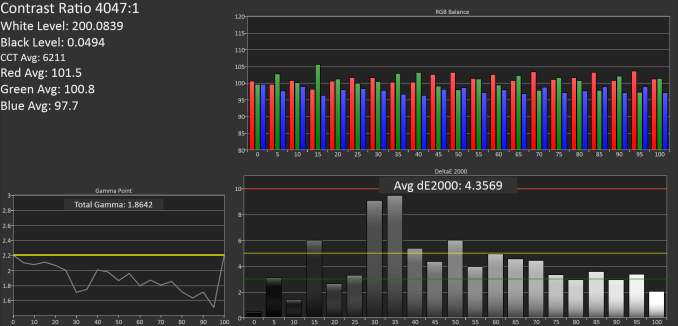
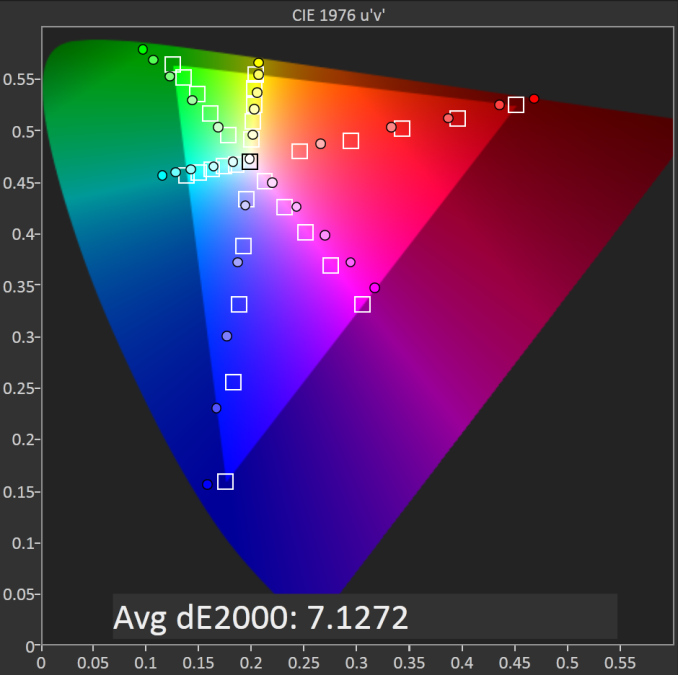









136 Comments
View All Comments
Ortanon - Wednesday, November 12, 2014 - link
=(seanleeforever - Wednesday, November 12, 2014 - link
Nexus lines were speed on cheap. after owning few nexus devices i made the jump to Note 4 and could not be happier.like DLeRium said, i have always been EXTREMELY disappointed in nexus line for everything other than processor power. looks like the Nexus 6 is no different. the battery life test shows how far behind the nexus line is to samsung's device given the same spec.
and those camera shots, eventhough it a improvement to the old, is not that great.
and most importantly, note 4 cost 550 dollar (750-200 if pre ordered in the U.S.), it is superior than nexus 6 in nearly every area. there is no sense in getting the nexus 6.
Vepsa - Wednesday, November 12, 2014 - link
Having owned a Galaxy Nexus and a current Note 3, I am very glad Verizon will be getting the Nexus 6. I cannot stand TouchWiz and find my self doing a lot more on my Nexus 7 that I do on my Note 3. Yes, the camera isn't as good and the Exchange client isn't as good, but I prefer the stock Android experience a lot more. Now if you'll excuse me, I must check for the Lollipop update on my N7 again (2013 LTE).seanleeforever - Wednesday, November 12, 2014 - link
that's the beauty of andriod, everyone has his/her favorite flavor.there was a period of time where i preferred stock andriod, which was why i had few nexuses, including the original nexus one. the main issue was the UI response. when hardware were underpowered, the UI response between a stocked andriod and skinned andriod was huge. however, at least in the Note 4 (sd 805), there is no trace of slowing down running touch wiz (and note 4's touch wiz is quite different from note 3). read any review any where and you can see it.
then it comes to functionality. it is safe to say the reason it is called the note is because the pen and the mufti-tasking it brings. if you just want a big screen, there are number of alternatives. and touch wiz is just brilliant way of doing multi tasking, whether to minimize a window or doing split screen. and the pen interface is also brilliant. you cannot get those support in stock andriod. there really isn't anything that stock can do that touch wiz cannot, but the opposite isn't true at all.
wolrah - Wednesday, November 12, 2014 - link
FYI, the pen works just fine in AOSP ROMs. My housemate has a Note 3 running Cyanogenmod and has no problems with it.Multitasking in both split-screen and popup forms has been available for some time in some AOSP ROMs and is available in most others through Xposed Framework extensions. Multitasking was one of the few things I liked on TouchWiz, so when I switched my GS4 over that was the first thing I installed.
AOSP out of the box may not have all the same apps that TouchWiz bundles, but there is nothing I'm aware of that can not be replicated with easily installed free apps.
seanleeforever - Wednesday, November 12, 2014 - link
there are levels of "working", i don't suppose his Note 3 has the pen shortcuts that's available the moment he pull out the pen, or screen write with ocr, or s note sync between devices? of course then you could say: there is an app for that, drop box to sync files and etc.. but why change something that's not broken? let alone of the inconvenience it brings?alternatively, i would like to say, what could you not do on stock touch wiz that you could do on AOSP?
nowadays, it is really a personally preference to mod the rom not a necessity (sort like how i like build my own PC rather than buy one). in fact, stock rom will likely cause reduced performance/battery life. just check out the google play edition of S4 and One.
akdj - Friday, November 14, 2014 - link
I'm with SeanLee hereAs a Note user (1 & 3 --- on NEXT so I'm paid off next month and I'll be selling to update to the N4) as well as Nexus owner, several phones, Nexus 7 (bothe the '12 & '13 models) ...even the original Xoom hangin with iPad 1 in a box, in the closet somewhere.
I'm 43 now. We own a family business, have mortgages, car payments, coaching baseball and wrestling and 'enjoying' my technology hobby if and when given the chance
When the chance comes, I'm different today than five years ago. I don't want to flash my ROM, hang out at XDA or troubleshoot challenges post root
I want a phone or a tablet that 'works', that's supported (widely and by typically trust worthy and hard working/creative and detailed developers) by the Play Store, easy to update and find what I need with support if I 'F' something up!
I'm also a user of iOS. iPhone is my personal set. iPad my tablet of choice and the Note 3 (this afternoon the N4) specifically for business and is with me everywhere.
I don't wear 'skinny' jeans, but I've never had an issue getting the Note 3 in my pockets. I'm with the author as well. Years of iOS usage for phones and the Note (specifically the '3'---I couldn't get outta the original Note quickly enough!) changed that for me.
That said, this new Nexus does look to be a let down with the price hike without the 'calibration' and efficiency of the other flagships on the market. The hardware, camera, even design look great! But over 5/5 ½" without a stylus but smaller than an iPad seems ...maybe not useless, to me.
Maybe the better word would be overkill
Anyway, as always, YMMV
mlambert890 - Saturday, December 20, 2014 - link
Odd because I immediately noticed UI hitching on the Note 4 AT THE SAMSUNG kiosk and immediately wrote it off. Dealt with it on the Note and Note 2... Not interested.Of course as with all things if you don't WANT to notice it you probably won't
Despite having near desktop level power the Note 4 absolutely still slows down thanks to TouchWiz though.
Jdotjdot7 - Wednesday, November 12, 2014 - link
Nexus lines were pretty decent. I just got the Nexus 5 like 3 months ago and I honestly can't say I'd choose any other smartphone currently. It was cheap as hell, I've had screen-on times over 6 hours and it's just a nice little phone that doesn't lose its appeal with age, something very rare in smartphones. I'd still choose a Nexus 5 even among the current crop, I was expecting to at least somewhat like the Nexus 6 but this review basically showed that Google went in the opposite direction.Spunjji - Friday, November 14, 2014 - link
This definitely reflects my own sentiments. I'm actually rather pleased; for the first time ever I've owned an Android phone for more than 12 months without wanting to replace it / throw it at a wall.